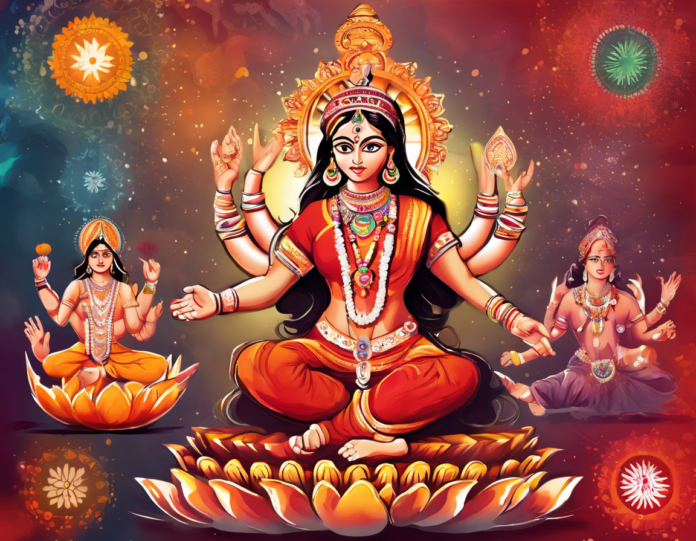Navratri, a festival dedicated to the worship of Goddess Durga, is a significant Hindu festival celebrated with great fervor and devotion across India and many other parts of the world. The festival typically lasts for nine days and nights, with devotees observing fasts, praying, and participating in various cultural activities. One of the most important rituals during Navratri is the Sthapana of the Goddess Durga idol or Kalash in the home or community pandals. The Sthapana ceremony marks the beginning of the nine-day festival and is conducted with great reverence and auspiciousness.
In this guide, we will provide you with a comprehensive overview of the 2024 Navratri Sthapana Muhurat, highlighting the auspicious timings and procedures to conduct the ritual. Additionally, we will delve into the significance of Navratri, the symbolism behind the Sthapana ceremony, and offer practical tips to make the occasion memorable and spiritually uplifting.
Significance of Navratri:
- Navratri, which means “nine nights” in Sanskrit, is a festival that symbolizes the triumph of good over evil.
- The festival is dedicated to worshipping various forms of Goddess Durga, who embodies the divine feminine energy.
- Navratri is celebrated twice a year: Chaitra Navratri in the spring and Sharad Navratri in the autumn. The Sharad Navratri, celebrated in September/October, is the most popular and widely observed.
Importance of Sthapana:
- The Sthapana of the Goddess Durga idol or Kalash is a pious ritual that invites the divine presence into the home or community.
- It is believed that during Navratri, the Goddess descends to Earth to bless her devotees and bestow them with strength, wisdom, and prosperity.
- Sthapana is performed with specific mantras, offerings, and rituals to invoke the grace of the Goddess and seek her blessings for protection and well-being.
2024 Navratri Sthapana Muhurat:
- Navratri in 2024 is expected to begin on Thursday, 26th September, and conclude on Friday, 4th October.
- The auspicious Muhurat for Sthapana may vary depending on the location and the planetary positions. It is advisable to consult a pundit or a local temple for the exact timings.
- Generally, the best time to perform the Sthapana is during the Pratipada Tithi (the first day of Navratri) or the Amavasya (new moon day).
- The morning hours, preferably between 6 am to 10 am, are considered highly auspicious for the Sthapana ceremony.
How to Perform Sthapana:
-
Prepare the Altar: Cleanse the designated area where the idol or Kalash will be placed. Decorate it with flowers, rangoli, and incense to create a sacred space.
-
Invoke the Goddess: Perform Ganesh Puja to remove obstacles followed by Kalash Sthapana by filling the Kalash with water, rice, durva grass, and placing Mango leaves on the mouth of the Kalash. The Goddess Durga idol can also be placed on the altar, along with other auspicious items.
-
Chant Mantras: Recite Durga Chalisa, Durga Stotra, or other Durga mantras to invoke the blessings of the Goddess and seek her protection and guidance.
-
Offerings and Aarti: Offer flowers, incense, lamp, fruits, and sweets to the Goddess. Perform aarti with devotion and surrender.
-
Prasad Distribution: After the puja, distribute prasad to the family members and guests as a blessing from the Goddess.
Tips for an Auspicious Sthapana:
- Purity: Maintain physical and mental purity during the Sthapana ceremony by observing fasts, meditation, and positive thoughts.
- Unity: Encourage family members to participate in the ritual to create a sense of togetherness and devotion.
- Charity: Donate to the poor and needy as a way of expressing gratitude for the blessings received during Navratri.
- Daily Puja: Perform morning and evening pujas with devotion throughout Navratri to deepen your spiritual connection with the Goddess.
- Recitation: Chanting Durga mantras or stotras daily can amplify the spiritual vibrations in your home and bring divine blessings.
Frequently Asked Questions (FAQs):
- When is the best time to perform the Navratri Sthapana in 2024?
-
The auspicious timing for the Sthapana may vary, but generally, the morning hours of the Pratipada Tithi are considered ideal.
-
What items are essential for the Navratri Sthapana ceremony?
-
Essential items include the Goddess Durga idol or Kalash, flowers, fruits, incense sticks, lamp, rice, and sweets.
-
Can the Navratri Sthapana be performed at a community pandal?
-
Yes, the Sthapana can be conducted at a community pandal where devotees gather to worship the Goddess collectively.
-
Is it necessary to fast during Navratri while performing the Sthapana?
-
Fasting is a personal choice and is not mandatory. However, many devotees observe fasts to purify their body and mind during Navratri.
-
What are the main mantras recited during the Navratri Sthapana?
- Some of the main mantras include the Durga Chalisa, Durga Stotra, Devi Kavach, and Durga Ashtottara Shatanamavali.
In conclusion, the Navratri Sthapana ceremony is a sacred and auspicious ritual that marks the beginning of the nine-day festival dedicated to the worship of Goddess Durga. By following the prescribed rituals, observing purity, and engaging in devotional practices, devotees can invite the blessings of the Goddess into their homes and hearts, bringing prosperity, protection, and spiritual upliftment. May this Navratri be a time of joy, peace, and divine grace for all those who participate in the celebrations.









